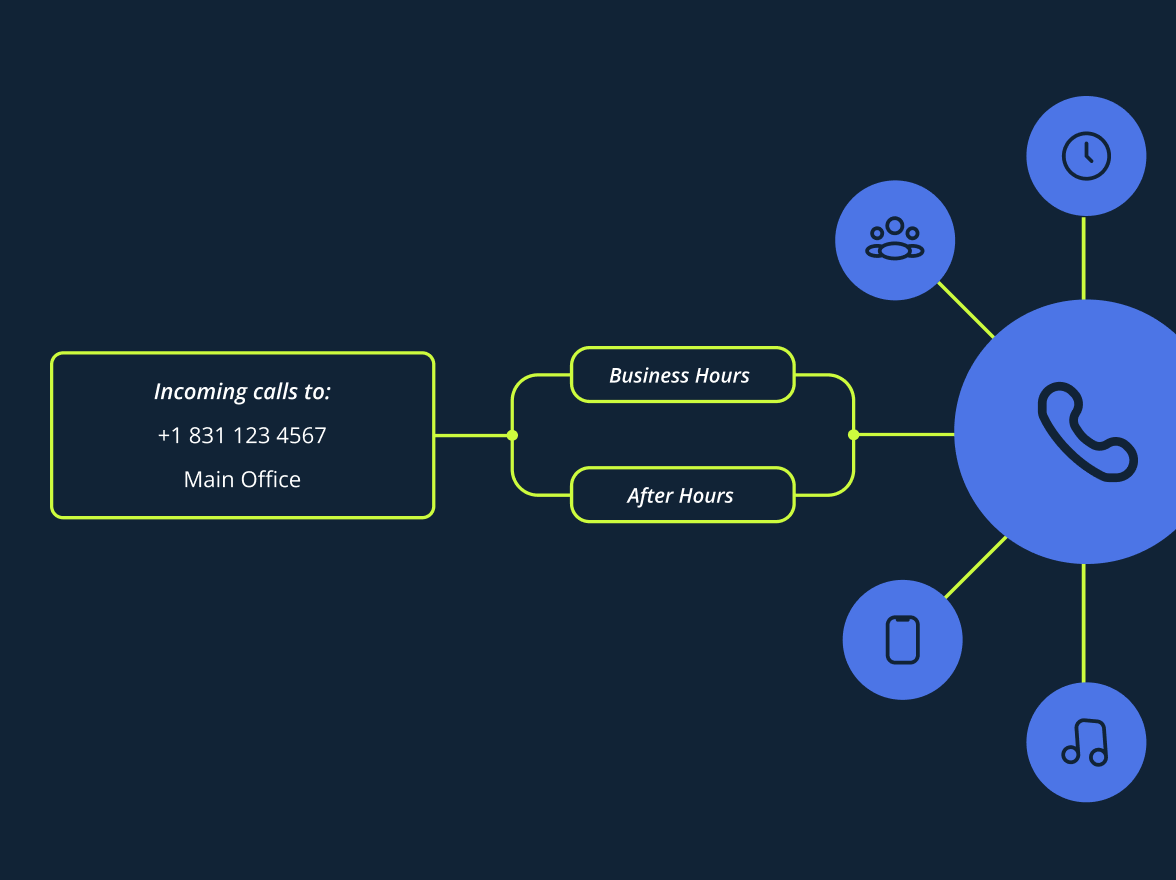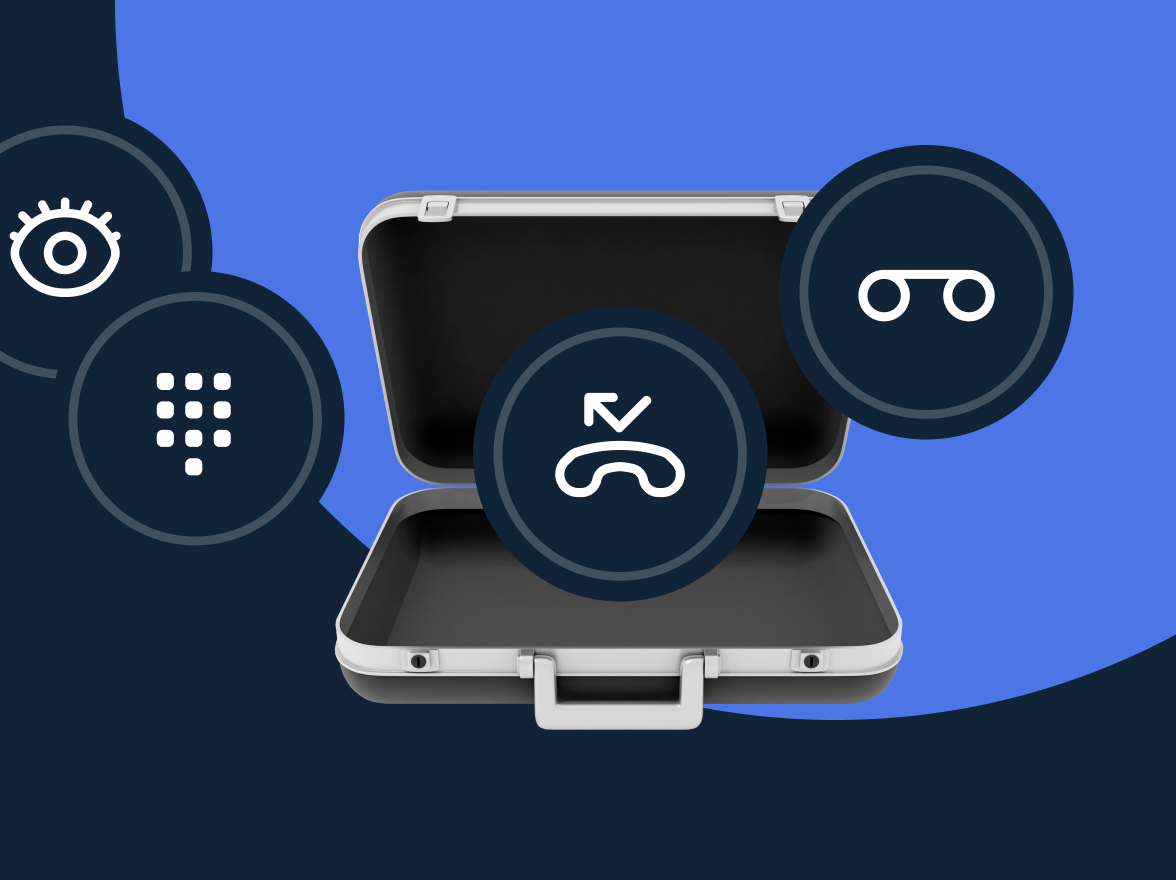If your business handles large volumes of calls, you are most likely already familiar with the concept of call flows in call centers. They are an integral part of ensuring that customers are routed to the right departments while also improving overall operational performance. This article explores the types of call flows, common challenges in managing them, and the future of it all.
What is a call flow?
Call flows are structured paths that incoming phone calls follow within a business’s communication system. They are essential in directing calls to the appropriate departments or individuals based on specific criteria. It can be guided by the time of the phone call, the caller’s input, or the reason for calling. This system ensures that callers are connected to the right person who can address their needs, improving the overall process.
The entire mechanism of this process seems to be relatively simple. When customers call, they are guided through a series of selections determining who within the organization is best equipped to handle their inquiry. This is done with specialized VoIP or call center software that organizes and manages the flow of calls.
Elements of an ideal call flow
A call flow typically includes several key stages designed to route incoming calls through a business’s communication system.
Call initiation
The first step of the call flow process starts when a customer dials in. It sets the stage, so to speak. The system recognizes the call and triggers the flow.
Greeting
An automated greeting is played to welcome the caller. This greeting is the first verbal (metaphorically speaking) interaction the caller hears when they are connected. This message often briefly mentions the company name and any relevant information about call recording policies or service hours.
Setting up the IVR
The caller is presented with a menu of call flow options. These options can include different departments, services, or common inquiries. The menu is usually managed through an Interactive Voice Response system. The phone tree prompts the caller to select an option by pressing a number on their keypad.
Option selection
The caller makes a selection based on their needs. This input dictates the subsequent path of the call flaws within the system.
Call routing
The call is routed to the appropriate queue or department depending on the selection. Routing can be based on factors such as staff availability, the specific request made by the caller, or the priority of the call.
Waiting queue
If all operators or service agents are busy, the caller may be placed in a waiting queue. They might hear music or messages regarding waiting times or additional services during this time.
Call handling
Once an agent is available, the call is connected. The agent will have access to the caller’s selections and any relevant customer information to provide a personalized and informed response.
Closure
After addressing the caller’s concerns, the call is concluded. Depending on the provider, the system may offer the caller the option to leave feedback, speak to another department, or end the call.
These steps are typically customizable and should be used as helpful tips. Based on your provider and contact center’s specific requirements, you can apply them to create the ideal call flow.
The importance of call flows in call centers
These flows are essential components in the operations of call centers, acting as the backbone for managing customer interactions. Here are some recognized benefits of call flows:
- Uniform customer experience: According to the ACSI stats from 2024, the average customer satisfaction score in the U.S is around 77.3%. And what do customers typically crave? Consistent interactions with fast resolutions to their issues. This is where the importance of call flow comes to the forefront. This ensures that every customer interaction is consistent by standardizing call handling. This uniformity builds trust and reliability, as customers have clear expectations each time they contact.
- Improved agent performance: According to a Cornell University study, 87% of call center agents consider their jobs stressful. They mentioned that customers sometimes blame them for things that are out of their control. With that in mind, having clearly defined, effective call flows can make their lives easier and more productive. Contact center agents receive calls that align with their specific skills, allowing them to address issues faster.
- Handling of peak volumes: Call flows are designed to manage higher call loads during busy periods by routing calls according to set rules, ensuring the system remains manageable.
- Adaptable operations: Call centers with flexible phone call flows can adjust their operations easily based on changing demands. This adaptability is crucial for adapting to market fluctuations or changes in operational requirements.
How do you create an effective call center call flow?
Implementing an omnichannel call center call flow requires a call management system that integrates multiple communication channels. MightyCall is one example of a call center system that supports such integration. Here’s a detailed look at how you can implement an omnichannel call structure using MightyCall:
- Set up a centralized dashboard: First, integrate all communication channels, such as phone, email, text, and social media, into MightyCall’s centralized dashboard. This step ensures that all customer interactions are accessible from one place, helping agents to manage communications.
- Design call flows: Using MightyCall, design specific call flows that automatically route customer inquiries based on defined criteria such as caller input, time of day, or agent expertise. Appropriate options are crucial for directing customers to the right resource without manual intervention, ensuring a smooth experience across channels.
- Implement automated systems: Set up automated responses for frequently asked questions across all channels within the phone system. This helps provide immediate responses to common queries, reduce wait times, and relieve some of the agents’ workloads.
- Synchronize data with CRM: Integrate MightyCall with your existing CRM system to ensure that all customer data and interaction histories are updated in real-time. This integration gives customer service agents a complete knowledge base at their fingertips, enabling an effective communication workflow.
- Test and run: Test your first efficient call flow to ensure it operates as intended across all channels. Adjustments may be necessary based on feedback and performance metrics. You can always use MightyCall’s call whispering feature to help your agents improve the overall customer journey.
Why try MightyCall’s call center?
If you’re looking for a simple yet efficient way to manage customer calls, MightyCall’s call flow system is a great option. It gives you a professional phone setup without the high costs or complicated call flows of big enterprise systems.
The platform is easy to use, with drag-and-drop tools to build your call flow, customizable IVR menus, a smart call routing system, and voicemail handling. All these features ensure that calls are answered quickly and efficiently. That means fewer missed calls and a better experience for your customers.
schedule your personalized demo with our amazing team

What are the different types of call flows?
There are different types of call flows that serve as important tools in customer service, helping businesses manage incoming calls and improve customer engagement and satisfaction. Depending on specific functions and requirements, they can vary significantly. Below are some primary types, detailed with examples and suitable use cases.
1. Sequential or linear call flow
A sequential call flow is the most straightforward type of call routing. In this setup, inbound calls are directed to an available agent or a common voicemail if no one is available. Every caller experiences the same sequence without any branching based on their input.
Ideal for small businesses with limited call volumes, linear call flows require minimal management and are free of complex routing. This simplicity ensures that customers reach the appropriate department quickly.
Benefits
- Ease of setup: Simple configuration of call flows without the need for advanced technical knowledge.
- Low cost: Minimal resources required, making it budget-friendly.
- Quick response times: Direct routing reduces wait times for customers.
Example
- If you press Option 1 for sales, you’re connected to a sales team member.
- If you press Option 2 for support, you’re connected to a support team member.
That’s it—no additional options or complexities.
2. Simultaneous call flow
Simultaneous call flows ring multiple agents simultaneously, and the first agent to pick up handles the call.
Ideal for businesses that prioritize rapid response times and want to reduce customer wait times.
Benefits
- Faster response times: Increases the likelihood of an immediate answer.
- Customer satisfaction: Reduces the chance of calls going to voicemail.
- Maximized availability: Makes full use of all available agents.
Example
An incoming call rings on all available support team members’ phones, and the first to answer assists the customer.
3. Round-robin call flow
Round-robin flows distribute incoming calls evenly among a group of agents, ensuring that each agent receives calls in turn.
Perfect for teams where agents have similar skill levels, and it’s important to balance the workflow evenly to prevent burnout.
Benefits
- Fair distribution of work: Prevents overloading specific agents.
- Increased morale: Agents feel workloads are managed equitably.
- Consistent customer experience: All agents are equally accessible.
Example
Agent A receives a call, then the next call goes to Agent B, and the following one goes to Agent C. It cycles back to Agent A after all agents have taken a call.

4. Time-based call flow
Time-based call flows route calls differently depending on the time of day or week. This ensures that calls are handled appropriately, whether received during business hours, after hours, or on holidays.
Works best for businesses that operate in multiple time zones or want to provide extended support without overburdening staff.
Benefits
- Improved customer satisfaction: Customers receive appropriate responses regardless of when they call.
- Better resource management: Staff are only engaged during their working hours, promoting work-life balance.
- Flexibility: Ability to manage call flows during holidays or special events.
Example
- During business hours, calls are routed to your main office.
- After hours, calls are forwarded to an on-call agent or a voicemail with information about operating hours.
- For global companies, calls can be routed to different locations based on time zones.
5. Direct extension call flow
Direct extension call flows allow callers to reach a specific person or department by dialing an extension, bypassing general menus.
Preferred by businesses where clients often need to contact specific individuals or departments, improving response times and customer satisfaction.
Benefits
- Reduced wait times: Callers connect directly without navigating menus.
- Personalized service: Strengthens relationships by providing direct access to contacts.
- Increased productivity: Employees can manage calls more easily.
Example
- A caller dials the direct extension for the accounting department and is connected immediately.
- Employees can share their extensions with clients for direct access.
6. Skill-based routing and transfers
Skill-based call flows route customers to agents who have specific expertise related to the caller’s needs.
Used by support teams with agents specializing in different products or services, improving first-call resolution rates and customer engagement.
Benefits
- Better problem resolution: Customers reach the most qualified agent quickly.
- Faster service: Reduces the need for call transfers and hold times.
- Higher customer satisfaction: Personalized support leads to better experiences.
Example
- A customer with a technical issue is routed directly to a tech support specialist rather than to general customer service representatives.
- Language preferences can route callers to agents fluent in their language.
7. After-hours call forwarding
After-hours call forwarding routes calls received outside of regular business hours to a designated number, voicemail, or service.
Mostly implemented by businesses that need to provide support outside standard hours or capture opportunities that may be lost if calls go unanswered.
Benefits
- Never miss important calls: Design call flows so that critical calls are attended to quickly.
- Improved customer service: Provides assistance when customers need it most.
- Competitive advantage: Being available after hours can set a business apart.
Example:
- Calls after 5:00 p.m. are forwarded to an on-call staff member or an answering service.
- Urgent calls can be differentiated and routed to emergency support.
8. Auto-attendant call flow
Also known as an IVR system, auto-attendant call flows use a menu system to route callers based on their selections.
This type works for businesses of all sizes that want to direct calls without needing a live receptionist. It reduces wait times and improves the caller experience.
Benefits
- Automated call handling: Automates the routing process.
- Professional image: Presents a structured and organized front to callers.
- Scalability: Easily add options as the business grows.
Example
- “Press 1 for sales, 2 for support, and 3 for billing.”
- Sub-menus can further refine the routing based on customer needs.
9. Intelligent or automated call flow
Intelligent call flows use advanced technologies such as AI to analyze caller information and route calls to the most appropriate agent based on various criteria. Best for businesses aiming to provide personalized customer experiences and improve service through technology.
Benefits
- Personalized service: Tailors the experience to individual customer needs.
- Reduced handling times: Connecting customers to the right agent immediately.
- Data usage: Uses customer data for better service.
Example
- A returning customer is recognized by their phone number and routed to the agent they’ve previously interacted with.
- High-priority customers are automatically directed to senior support staff.
10. VIP call flow
VIP call flows prioritize calls from important customers, ensuring they receive immediate and specialized attention.
Perfect for businesses that want to offer premium service levels to certain customers, improving relationships and satisfaction.
Benefits
- Strengthened relationships: Shows appreciation for valuable clients.
- Improved retention: High-quality service encourages loyalty.
- Competitive edge: Differentiates service offerings.
Example
- Calls from high-value clients are immediately routed to senior account managers.
- Loyal customers receive shorter wait times and access to exclusive support lines.
Who uses call flow systems?
Call flows are widely used across various industries, moving beyond just sales and customer service. They help improve communication, handle inquiries smoothly, and improve overall customer retention. Below, we explore how different sectors adapt phone call flows to meet their specific requirements:
Healthcare
In the healthcare industry, communication is vital. Medical facilities and agencies use flows to manage patient inquiries, appointment scheduling, and emergency calls. For example, 911 Nurses GTA agency initially used basic cell phone systems for communication, which became inadequate as the company grew. MightyCall was introduced to support the increasing need for improved call management.

“We were able to arrange the call trees, so the calls are sent to each department for incoming calls. We have the automated message set up, and then it’s routed to our different departments. We have scheduling and we have the travel coordinators and we have recruitment and payroll, and that’s how we decided to set it up.”
Rhea Stoddart, Co-founder at 911 Nurses GTA
This setup allowed the agency to improve their communication, ensuring that patients and staff are connected to the right department quickly. By implementing a structured call flow, healthcare providers can improve response times, manage critical information securely, and increase patient satisfaction.
Construction
In the construction industry, call flows are crucial for managing project coordination, client updates, and supplier communications. They help direct contact center calls to project managers, billing departments, or maintenance requests. Thus, ensuring that all stakeholders stay informed and connected throughout the construction process.
Financial services
Banks and financial institutions benefit from customized call flows by routing customers to the right department for loan inquiries, account problems, or investment services. This ensures that customers receive specialist advice and helps in managing sensitive information.
10 tips for advanced call flow management
Managing call flows is important for maintaining high customer satisfaction and operational effectiveness. Here are 10 simple yet technical tips to help you make your flow perfect:
- Implement data-driven decision-making: Use analytics to continuously monitor and analyze key performance indicators (KPIs), such as average handling time (AHT), first call resolution (FCR), and customer satisfaction (CSAT). Use these insights to optimize call flows for effectiveness.
- Schedule quarterly reviews: Conduct detailed reviews every three months to analyze data, assess call center agents’ performance, and identify areas for improvement. Integrate logging mechanisms within the call flow process to track all live agent interactions and data access. This provides a clear audit trail for compliance reviews or security incidents.
- Analyze post-peak performance: After high-volume periods, critically assess how your call optimization handled the increased load. Use this analysis to fine-tune processes to manage similar future events better.
- Maintain ongoing monitoring: Implement systems for real-time monitoring to identify and address issues promptly. React quickly to shifts in KPIs to mitigate potential impacts on customer satisfaction. This will improve your call flow efficiency.
- Monitor call abandonment rates and customer feedback for CSAT: Keep a close eye on how many customers hang up before reaching an agent. High abandonment rates may indicate issues with the call routing system or excessive wait times. Use tools such as post-call surveys to gather customer feedback. Analyze this caller data to refine your call system and improve the overall customer interaction.
- Secure customer data: Ensure all call flows adhere to strict data privacy protocols, including encryption and restricted data access. Protect sensitive customer information and reduce the risk of data breaches.
- Ensure regulatory compliance: Create a structure compliant with relevant regulations such as GDPR, HIPAA, or PCI DSS. This includes ensuring all automated call recordings adhere to consent and storage requirements.
- Enhance IVR security: Require secure authentication within IVR call flow systems for sensitive interactions such as payment processing or account verification to protect against unauthorized access.
By keeping these tips in mind, you can ensure your call flow management is effective, secure, and responsive to customer needs.
Examples of call flows
Here are call flow examples that are used in sales and customer service environments.
Call flow in technical support
- Initial greeting: The call begins with an automated message that thanks the caller for reaching out and offers a brief overview of common technical issues and solutions.
- Menu options: The caller is given a choice of options, such as troubleshooting hardware, software support, or network problems.
- Routing: Depending on the selection made, the call is directed to a specialist with expertise in the relevant area (hardware, software, or network).
- Call queue: If all specialists are busy, the caller is placed in a queue. While waiting, the system provides tips on basic troubleshooting steps or recent updates that might solve everyday problems.
- Post-call and queue-end options: At the end of a call, customers can choose to receive a follow-up call or email with additional resources or schedule an appointment for further support if needed. Similarly, when no agents are available, calls can be routed to voicemail, allowing customers to leave their contact information to ensure their concerns are addressed.
Call flow in sales
- Initial greeting: The call starts with an automated greeting acknowledging the caller and providing information about current promotions or products.
- Menu options: The caller is presented with a menu to choose between speaking with a sales representative, learning more about products, or hearing more about deals.
- Routing: If the caller opts to contact a representative, the call is routed to an available salesperson who can handle inquiries or facilitate a sale.
- Call queue: If no representatives are available immediately, the caller is placed in a queue with promotional material or music played during the wait.
- Post-call and queue-end options: After a call, customers can subscribe to newsletters or receive updates about future promotions. Additionally, when no agents are available, calls can be routed to voicemail, allowing customers to leave their contact information and address their concerns.
Call flow in customer service
- Initial greeting: Call flows start with a greeting and an offer to choose from options such as technical support, billing, or account management.
- IVR interaction: The caller may interact with a phone tree system for common issues such as billing inquiries or account updates. It should be capable of resolving these issues without live agent intervention.
- Routing to agent: If personal assistance is needed, the call is directed to an appropriate call center agent based on the complexity of the issue and the agent’s expertise for a continued conversation flow.
- Information during the wait: Throughout the waiting period, the system might provide relevant information or updates to keep the caller on the line informed.
- Feedback collection: After the service is provided, customers may be directed to complete a satisfaction survey to measure service quality and identify areas for improvement. This step pretty much sums up the customer service call flow.
Overcoming challenges in call flow management
Call centers often encounter specific challenges when implementing and managing call flows, and overcoming these obstacles is critical for ensuring smooth operations. Here are some tips for handling common challenges and some strategies to address them:
- Call volume overload: Managing high inbound call volumes without overwhelming the system is a recurring issue. Implementing a well-designed queuing system that prioritizes calls based on urgency or customer type can help distribute the load. Integrating features such as callback options allows customers to avoid long hold times, improving overall satisfaction.
- Over-automation risk: Relying too heavily on automation can result in a lack of personal connection with customers, leading to frustration and failure to understand the call driver. Use workflow automation for routine tasks and quick resolutions while ensuring that more complex or sensitive issues are directed to live agents. Blending automation with human contact provides a better customer experience.
- Misrouted calls: Poor call routing can lead to customer frustration. Phone call flows should be designed with intelligent routing based on real-time agent availability, skill sets, and call types. Regularly reviewing routing data and adjusting based on call center metrics performance can help reduce misrouted calls.
- System integration difficulties: Integrating new call flow software with existing CRM and business tools can be a challenge, especially if systems are outdated or incompatible. Select software that offers strong integration capabilities and works well with your current setup. Having the option to book a 1-1 demo or a white glove setup with the software provider will help with the proper integration. The software provider might also share some useful tips.
Looking forward: the future of call flow technologies
AI-driven systems, omnichannel integrations, real-time analytics, voice recognition, and personalized customer experiences will shape the future of call flow technologies. As automation advances, call work will become more advanced. Call flows will handle more complex tasks and allow for easy transitions between communication channels. To stay competitive, businesses should partner with providers that automatically adopt new industry standards.
Business communication services such as MightyCall ensure that companies remain equipped with the latest advancements without manual upgrades. This approach is important for delivering effective, customer-focused interactions in the changing landscape of call center workflow management.




























